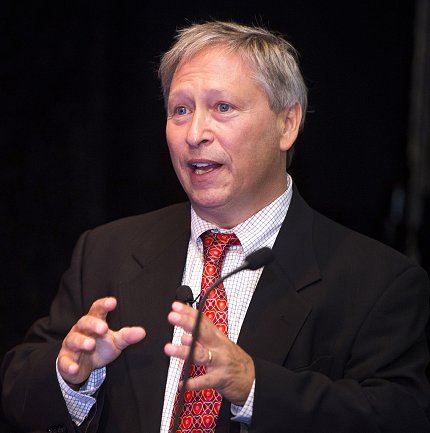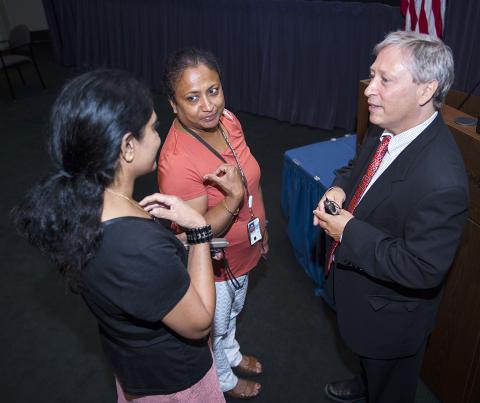Improving Function, Lowering Costs?
Evidence Grows of Tai Chi’s Benefits, Including for Seniors

Photo: Lisa Helfert
It’s surprisingly difficult for anyone to walk and think—let alone chew gum—at the same time. For seniors, walking and mental processes can become even more difficult, with falls and cognitive decline often major fears as well as high public-health burdens. One nondrug complementary approach being studied for healthier, safer aging is tai chi. In a recent NIH lecture, Dr. Peter Wayne discussed the overall evidence on tai chi’s use for medical purposes, as well as some of his team’s studies on its use to prevent falls and protect cognitive function in older people.
Wayne is an associate professor of medicine at Harvard Medical School, research director for the Osher Center for Integrative Medicine in Boston, an NIH grantee and a tai chi teacher. He gave his talk as part of NCCIH’s Integrative Medicine Lecture Series.
Tai chi (short for tai chi chuan) comes from various Asian traditions, including the martial arts and traditional Chinese medicine. Wayne described tai chi as a mind and body therapy that’s “multimodal, integrative and ecological,” and, in contrast to most Western medical care, moves toward unifying rather than treating separately the mind and body and the different organ systems.
Tai chi has many styles, but all have certain “active ingredients” in common, he added. These include slow exercise movements that are moderately aerobic, muscle-strengthening, weight-bearing and flexibility-enhancing; cognitive training, e.g., in mental focus and heightened body awareness; breathing patterns; and social and philosophical dimensions.
There is preliminary evidence, including from systematic reviews and meta-analyses, Wayne said, of tai chi’s benefit in a number of health problems in older adults. Examples include balance issues, falls prevention, chronic heart failure, osteoporosis, osteoarthritis, COPD, asthma, Parkinson’s disease, stroke, depression, cognitive function, cancer symptoms and pain (a relatively new research topic). “[Overall] the evidence is growing, promising and suggestive,” he said, “but we also need to be careful how far we go in interpreting these data,” owing to quality issues (an issue not unique to this field). One encouraging trend, he noted, is that the proportion of studies on tai chi that are randomized controlled trials has steadily risen in recent years.

Photo: Lisa Helfert
Wayne has been a principal or co-principal investigator on grants from NCCIH to study tai chi in older people—for example, to improve balance, gait (manner of walking) and physical function and to determine whether it might reduce health care utilization and costs. Among his published studies so far: he and his team found preliminary support in tai chi for improvements in executive function, mainly in healthy older adults, and in global cognitive function, mainly in older adults who already had mild cognitive impairment. His team has also seen tai chi interrupt and even reverse the “vicious cycle” of older adults becoming so afraid of falling that their lives become increasingly restricted, which leads to even worse health. Tai chi also appeared to increase self-efficacy, or the belief and confidence that one can do things—one reason that Wayne calls it “a gateway exercise.
“There’s a burgeoning body of literature that [motor and cognitive] functions are interdependent,” Wayne noted. For example, in work pioneered by Dr. Joe Verghese at Einstein School of Medicine, a slower-than-normal gait for one’s age could place one at a higher risk for dementia than a peer with a more normal gait speed.
These “complex cognitive-neuromuscular interactions” are of interest in Wayne’s current NCCIH-funded trial of whether tai chi shows benefit in healthy people at least 60 years old when challenged to “dual task”—to perform a walking task and a cognitive task (such as counting backward by 7’s) at the same time. The three study groups consist of healthy people new to tai chi who receive 6 months of instruction in it, along with usual care; matched controls receiving usual care only; and expert tai chi practitioners.
Wayne’s group is collaborating with the Motion Analysis Laboratory at Spaulding Rehabilitation Hospital in Boston. By attaching markers to the body and using 3-D motion-capture technology, the researchers are able to quantify and create advanced models of tai chi movement with respect to biomechanics, joint movement, postural sway, balance and other variables. The team is also studying cognitive outcomes and biological markers of aging.
Wayne described unique challenges in studying complex mind-and-body therapies—such as teasing out “specific” from “non-specific” effects (the latter arising not from an intervention but rather from factors such as the study environment or attention from a professional), what to use as a control group and the right “dosage” of the therapy. Among the ways investigators are taking on these challenges are pragmatic study designs, new metrics and technology. For example, he and his colleagues are developing a smartphone program that can guide a tai chi study member in attaching sensors to his or her body for daily practice and then take measurements of the practice.
Wayne concluded, “I think it’s fair to say that tai chi is a promising intervention for preserving and enhancing a number of domains of health, especially in older adults. There’s enough here to make us want to keep looking.” It’s also generally safe; in his 2014 systematic review of adverse events reported from tai chi clinical trials, he found the only side effects to be occasional aches and pains typical of exercise.
The entire lecture is available at https://videocast.nih.gov/Summary.asp?Live=19669&bhcp=1.
